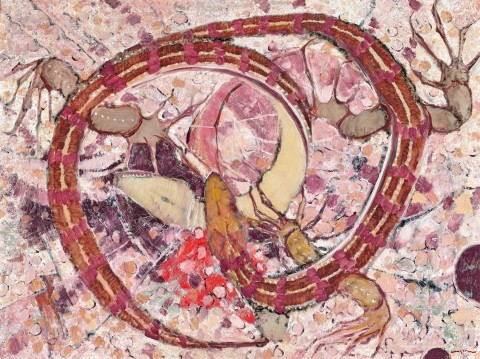TERRITORIAL IMPERATIVE, 1979
CLIFTON PUGH
oil and enamel on composition board
91.5 x 122.5 cm
signed lower right: Clifton
signed, dated and inscribed with title verso: “TERRITORIAL IMPERATIVE” 79 / Clifton Pugh / Hurstbridge
Tolarno Galleries, Melbourne
The National Australia Bank Art Collection, acquired from the above in June 1981 (label attached verso)
The Seventies: Australian paintings and tapestries from the collection of National Australia Bank, National Gallery of Victoria, Melbourne, 15 October – 28 November 1982
Collection of Modern Art in the Seventies, Latrobe Valley Arts Centre, Victoria, 9 May - 2 June 1985
The Seventies: Australian Paintings and Tapestries from the Collection of National Australia Bank, Geelong Art Gallery, Victoria, 30 April - 29 May 1988
The Seventies Exhibition: Selected Paintings from the National Australia Bank Collection, MacLaurin Hall, The University of Sydney, Sydney, 6 September - 1 October 1989, cat. 29
'The Seventies' Exhibition: Selected Paintings from the National Australia Bank Collection 'Modern Art of the Seventies', Caulfield Arts Complex, Melbourne, 18 January - 11 February 1990, cat. 18
The Seventies: Contemporary Australian Paintings from the National Australia Bank Collection, organised by Regional Galleries Association of New South Wales, New South Wales, cat. 23; and touring, Tamworth City Art Gallery, New South Wales, 24 May – 24 June 1990; Dubbo Regional Art Gallery, New South Wales, 11 July – 6 August 1990; Wagga Wagga City Art Gallery, New South Wales, 17 August – 10 September 1990; Moree Plains Regional Gallery, New South Wales, 3 October – 31 October 1990
Lindsay, R., The Seventies: Australian paintings and tapestries from the collection of National Australia Bank, National Bank of Australasia, Melbourne, 1982, pl. 74, p. 87 (illus.)
Sturgeon, G., Australia: The Painter's Vision, Bay Books, Sydney, 1988
Territorial Imperative, 1977, oil on composition board, 122.0 x 91.0 cm, private collection, illus. in Allen, T., Patterns of Life: Clifton Pugh, Melbourne, 1981, p. 79
In response to international art’s shift away from figurative painting a gaggle of Australian artists got together in August 1959 and, after much debate around the wording, published The Antipodean Manifesto. The objective was to preserve and promote the values of figurative painting in Australia, against a tide of international influence. Pugh was adamant that unlike some in the group, he had nothing against abstract art, he simply believed that nonfigurative painting had it limitations in its ability to communicate. Rebutting the accusation that The Antipodeans were anti-art, Pugh wrote to the press to clarify his position: ‘…all sincere directions of Art are valid, but how far various methods go towards full expression and communication is another matter.’1
It is impossible not to consider Pugh’s appreciation of abstract art when viewing his best works. Using the Australian bush as a springboard, his inventive approach to colour, form and pattern conspires to create works which to the layman could easily be considered as abstract. His virtuosity with materials, along with his cavalier understanding of drawing techniques, helps bring his works to their spirited conclusion. Territorial Imperative, 1979 is an excellent example which demonstrates Pugh’s ability to fuse his draftsman ship with the expressive power of paint. In an everyday ritual, we see the two lizards twist and writhe as they seemingly fight to the death. The image of the tumbling lizards captures the moment that one dominates the other. The victor has its mouth firmly locked onto the throat of the loser as it turns belly up in defeat. The loser appears all but dead, yet as Pugh noted in a conversation with Robert Lindsay in 1981: ‘it’s a full fight of bluff, unlike humans they seem reluctant to kill each other.’2 And so, once the dance is over, we have a victor while the other lives to fight another day – or more likely becomes a meal for watchful eyes. The title, Territorial Imperative, was also the title of another painting in 1977, which similarly features creatures asserting their right to territorial dominance– in that instance, magpies defending their nest in full combat mode. Significantly, both works use camouflage and violence as a secondary theme – an influence that can be attributed to observations that remained with Pugh from his time serving in New Guinea during WWII.
The ground is a rich mix of household enamel paint overlayered with healthy daubs of oil paint. The material and colours harmonise to create a cacophony of surface activity and colour. His slap-dash manner of applying paint, with its raked, worked and melded surfaces has its roots in abstract painting, while the evolving image of the lizards anchor the work in the world of figurative painting – and in a way, the territorial imperative could perhaps be read as a metaphor for the skirmish the Antipodean manifesto caused in 1959. Whichever way we view it, the painting remains classic Pugh and its genesis is squarely at the feet of the abstract art movement that The Antipodeans viewed with such suspicion.
1. Pugh, C., Contemporary Art Society Broadsheet, August 1959
2. The artist, cited in, Lindsay, R., The Seventies: Australian paintings and tapestries from the collection of National Australia Bank, National Bank of Australasia, Melbourne, 1982, p.87
HENRY MULHOLLAND
